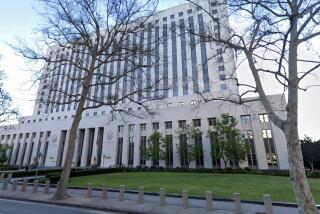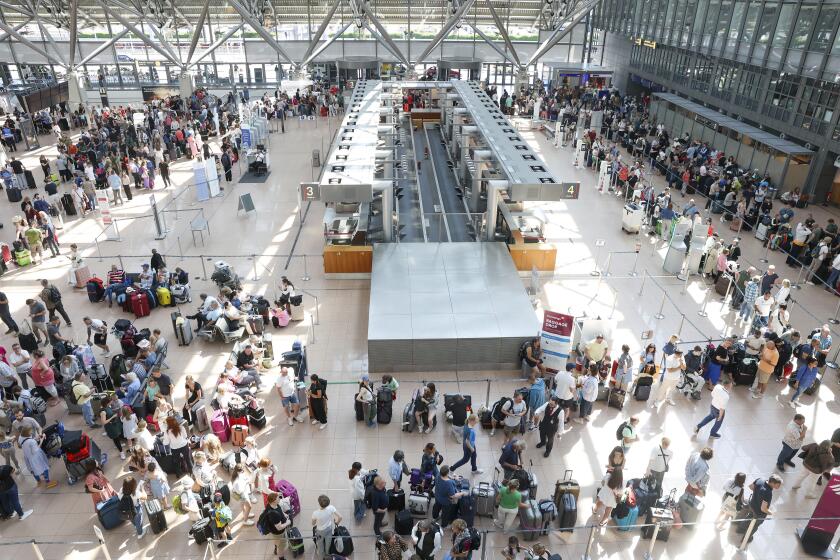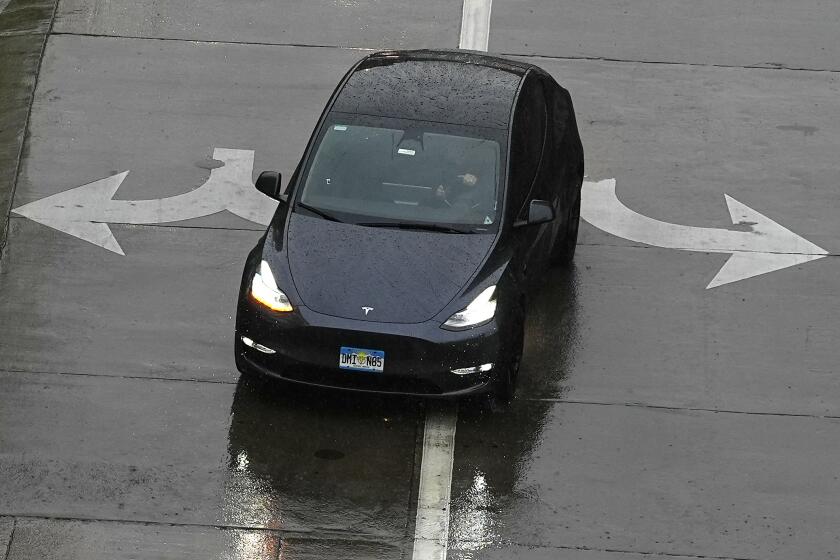Nice Idea on the (License Plate) Surface, but Too Costly
Dear Street Smart:
In California, license plates are issued that go with the car whenever it is sold. The registration month always stays the same. Why don’t they raise the letters on the license plate where the month sticker goes?
For example, the month of “JAN” could be printed in raised letters. Then the vehicle owner would only have to put one sticker on the side where the year goes.
There would be no more screw-ups of getting the year and month switched; the month sticker would never wear out and be unreadable on any future plates issued.
Although the small month stickers aren’t expensive to purchase, I am sure that the savings would quickly pay for any license plate machine retooling.
Other states do it this way--why not California?
Chuck Corpening
El Toro
While your idea certainly seems good on the surface, the cost of retooling would be anything but minimal, said William Madison, a spokesman for the California Department of Motor Vehicles.
That’s because the state currently has no fewer than 45 different types of license plates on its roads, each of which would have to be separately retooled.
In addition to the standard-issue plates for cars, commercial trucks, trailers and motorcycles, which come in six different formats, there are 14 special-interest, fund-raising plates issued for organizations such as the Yosemite Foundation and California Arts Council. And there are an array of “special recognition” plates identifying such things as antique motorcycles and historical vehicles, as well as cars belonging to ham operators, Pearl Harbor survivors, prisoners of war and press photographers, just to name a few.
“We have a proliferation of plates,” Madison said.
To raise the letters of the month on them, “we would have to produce 12 new plates for each one. It would be a major cost. It’s much less expensive to just have stickers on and if they start to fade, you put on a new one. Those stickers last a long time.”
*
Dear Street Smart:
I was under the impression that the reason for the carpool lane was to encourage ride-sharing, which would [reduce] the number of cars traveling on the freeway. If my assumption is correct, why is a mother with a child or, for that matter, any other person who has an unlicensed passenger allowed to use the carpool lane?
In the same regard, I think the experiment of allowing solo drivers to use the carpool lane for a set dollar amount is undermining the purpose of lessening traffic on the freeway.
When are the powers-that-be going to admit that the carpool lanes are not achieving their goal and open them up to all drivers, or at least allow single drivers to use carpool lanes during off-peak hours such as is allowed in the northern part of the state?
Paul A. Sax
Mission Viejo
You aren’t the first person to ask that question. A group called Drivers for Highway Safety has been lobbying against carpool lanes for years, arguing, as you do, that they are an ineffective way of reducing traffic on the freeways.
“Carpool lanes are dangerous, and they don’t work,” said Bill Ward, the group’s chairman. “All they do is move the carpools into one lane.”
Officials at Caltrans, however, disagree, arguing that the carpool lanes have reduced the number of cars on the freeways, despite what opponents say.
“The lanes have been successful,” said Maureena Duran-Rojas, a Caltrans spokeswoman.
As to why children or unlicensed drivers are allowed to qualify their driver for the carpool lane, she said, distinguishing unlicensed from licensed passengers would be a law enforcement nightmare.
“How do you pick out those who have a license and those who don’t?” Duran-Rojas said. “You can’t always determine that by looking.”
And in cases where you can, such as an adult with children, she said, “Why should three parents drive their children, when they can get one parent to shuttle three children?”
Regarding San Diego’s experiment of allowing solo drivers to use the carpool lane for a $50 monthly fee, transportation officials in Orange County say they are watching it closely and have hired a consultant to determine whether it would be appropriate here.
The San Diego officials conducting the experiment, however, say that they are determined to pursue it in a way that won’t, as you suggest, undermine the lane’s basic purpose.
“The lanes are not filled up,” Mario Oropeza, one of the planners, has said. “There is available space. If our census shows that the carpool lanes are filling up, we will merely raise the per-trip cost higher and higher until fewer people use it,” thus maintaining the incentive for car-pooling.
*
Dear Street Smart:
Why has the westbound Riverside Freeway been re-striped where it crosses the Santa Ana Freeway?
It seems that most of the traffic stays on the Riverside Freeway, yet the new arrangement removes a lane that used to be available to westbound Riverside Freeway cars. This situation has made the previous bottleneck even worse.
Frank Bollinger
Anaheim Hills
You’re right, so the problem has been remedied, Duran-Rojas said.
“There were complaints,” the Caltrans spokeswoman said of the striping done as part of an anticipated reconstruction project involving the Santa Ana/Riverside interchange. “It caused more of a bottleneck than we wanted to have out there.”
So during Christmas week, she said, Caltrans workers returned the interchange striping to its original configuration.
“It’s back the way it was,” Duran-Rojas said. “I haven’t gotten any more calls.”
Street Smart appears Mondays in The Times Orange County Edition. Readers are invited to submit comments and questions about traffic, commuting and what makes it difficult to get around in Orange County. Include simple sketches if helpful. Letters may be published in upcoming columns. Please write to David Haldane, c/o Street Smart, The Times Orange County Edition, P.O. Box 2008, Costa Mesa, CA 92626, send faxes to (714) 966-7711 or e-mail him at David.Haldane@latimes.com Include your full name, address and day and evening phone numbers. Letters may be edited, and no anonymous letters will be accepted.
More to Read
Sign up for Essential California
The most important California stories and recommendations in your inbox every morning.
You may occasionally receive promotional content from the Los Angeles Times.






